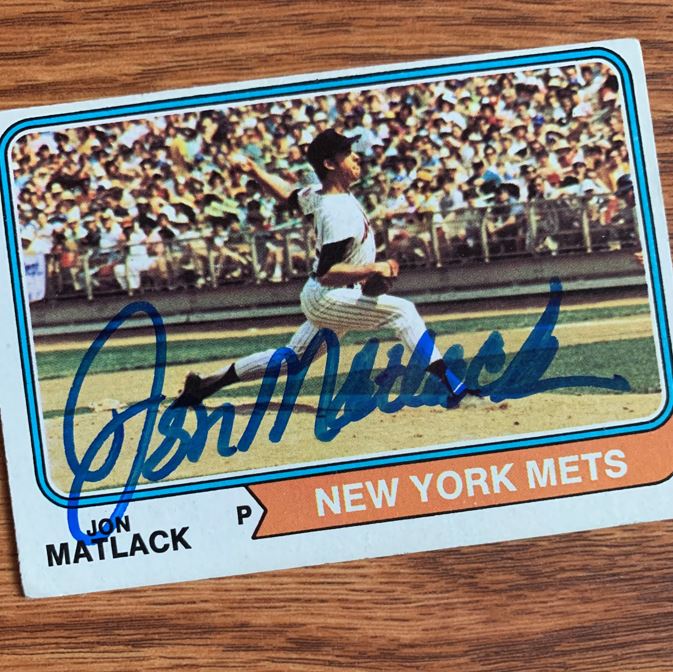
TTM Stats
- Sent: 7/13/2022 | Received: 8/2/2022 | 19 Days
- ’74 Topps, ’77 Topps
- Address: Home (address from Sports Card Forum)
- Sent: 4/4/2023 | Received: 5/8/2023 | 14 Days
- ’80 Topps, ’81 Fleer, ’84 Topps
- Address: Home (address from Sports Card Forum)
- Sent: 1/31/2024 | Received: 2/12/2024 | 12 Days
- ’76 Topps, ’82 Fleer, ’82 Topps, ’83 Donruss, ’84 Fleer, ’84 Topps
- Address: Home (address from Sports Card Forum)
- Sent: 3/22/2025 | Received: 4/7/2025 | 15 Days
- ’75 Topps, ’75 Topps Mini
- Address: Home (address from Sports Card Forum)
The Story of the Autograph
In an era rich with legendary pitchers, Jon Matlack often flew under the radar, but make no mistake, he was one of the most talented and reliable left-handers of the 1970s. A former National League Rookie of the Year, All-Star Game MVP, and cornerstone of the New York Mets rotation, Matlack’s career was marked by sharp control, steely poise, and quiet excellence. Though he never attained Hall of Fame status, his contributions remain deeply respected by those who watched him dominate from the mound.
Jonathan Trumpbour Matlack was born on January 19, 1950, in West Chester, Pennsylvania, and grew up in a baseball-loving family. He attended West Chester High School, where he stood out as a gifted pitcher, earning the attention of Major League scouts.
The New York Mets selected Matlack as the 4th overall pick in the 1967 MLB Draft, signaling high expectations for the lanky left-hander. After a few seasons of seasoning in the minors, he made his MLB debut on July 11, 1971, showing flashes of the talent that would soon make him a star.
Matlack’s breakout came in 1972, his first full season. He posted a 15–10 record with a 2.32 ERA and 169 strikeouts, earning him the National League Rookie of the Year award. His control, maturity, and ability to mix speeds made him a natural fit in a Mets rotation that included stars like Tom Seaver and Jerry Koosman.
While Seaver often got the headlines, Matlack quietly emerged as one of the most effective pitchers in the league. He made the All-Star team in 1974, 1975, and 1976, and in the 1975 All-Star Game, he earned co-MVP honors with Bill Madlock after pitching two scoreless innings and striking out four batters.
One of the defining moments of Matlack’s career came in 1973, when he helped lead the Mets to a surprising National League pennant. Though the Mets had a losing record late in the season, they surged in September and reached the postseason. Matlack was dominant in the playoffs, winning a game in the NLCS against the Cincinnati Reds.
In the World Series against the powerful Oakland A’s, Matlack was steady. He took the mound again in the decisive Game 7 but suffered a tough loss, as the Mets fell just short. Despite the defeat, his postseason poise cemented his reputation as a big-game pitcher.
Matlack remained with the Mets through the 1977 season before being part of a major trade that sent him to the Texas Rangers in a four-team blockbuster. In Texas, he continued to pitch well, especially in 1978, when he won 15 games with a 2.27 ERA.
Unfortunately, arm injuries began to take their toll. After the 1980 season, he missed a chunk of 1981 due to elbow problems and never fully regained his earlier form. He attempted a comeback but ultimately retired after the 1983 season.
Matlack finished his career with a 125–126 record, a 3.18 ERA, 1,516 strikeouts, and 97 complete games — numbers that reflect both his talent and the hard-luck nature of pitching for low-scoring teams.
After retiring, Matlack stayed close to the game. He worked as a minor league pitching instructor for several organizations, including the Tigers, White Sox and Padres, focusing on mechanics and mental preparation. Known for his thoughtful approach to pitching, Matlack gained a reputation as an excellent teacher of the craft.
Jon Matlack may not have the widespread fame of contemporaries like Seaver or Carlton, but those who followed 1970s baseball know just how good he was. A power-control lefty with a calm presence and competitive fire, Matlack’s name still brings a nod of respect from historians and longtime fans.
In Mets history, he remains a top-tier arm from their golden era, a vital figure in their 1973 pennant run and a consistent presence through much of the decade. As a Texas Ranger, he showed resilience and leadership even as injuries mounted.
Jon Matlack’s career is a reminder that greatness doesn’t always need a spotlight. Sometimes, it just needs a sharp fastball, a cool demeanor, and a relentless commitment to excellence.
The Score on Jon Matlack – 7.0


I love Jon’s signature. I’m sure that is partially because I am a homer Mets fan. But also, in the first return below, it just came out great, especially on that 1974 Topps card. But I think in combining all these pending posts together you can see that Jon has a bit of an inconsistent level of quality. That’s not on the way he signs, that more seems to be related to the marker that he uses. It almost seems like it’s dying on some of these.
Thanks, Mr. Matlack! I’m giving these returns a 7 overall.
These aren’t my first successful returns from him. To see the others, check out these posts:




>>> READ MORE ABOUT MY AUTOGRAPH SCORING SYSTEM <<<
Thanks for visiting BravestarrCards.com: Card Collecting and TTM Autographs.
Information gathered using Wikipedia and Baseball Reference.